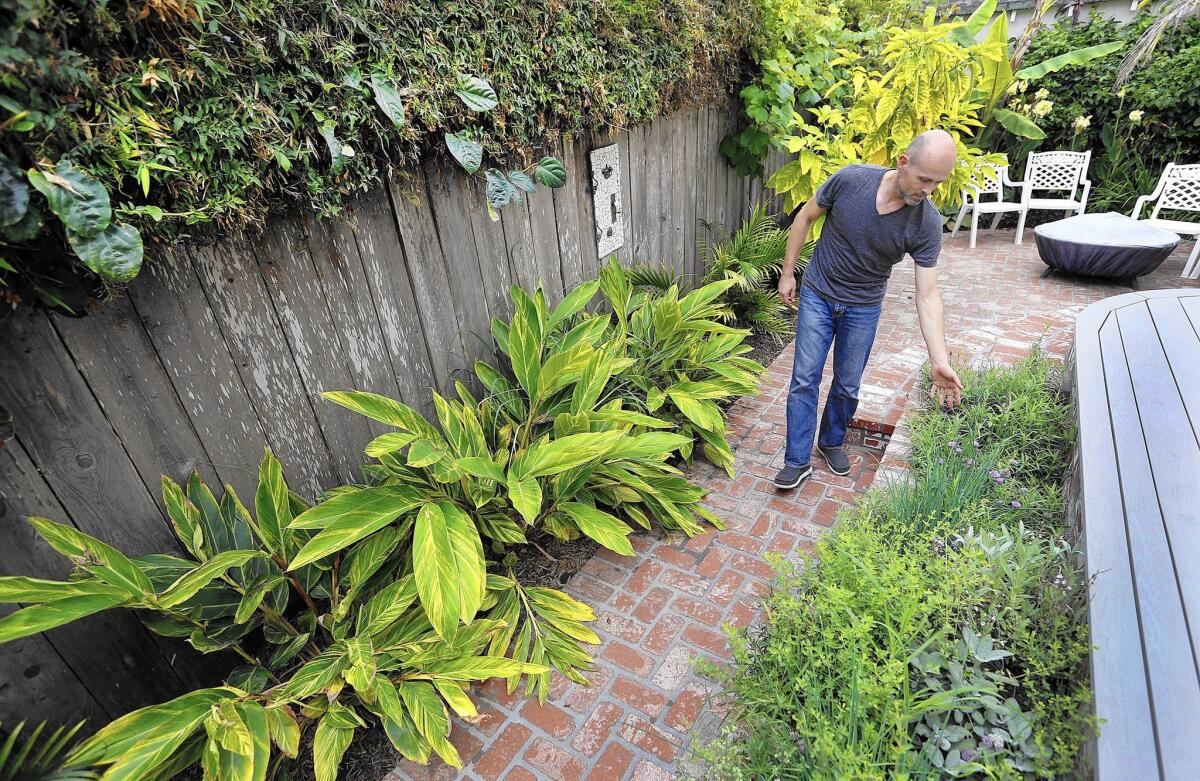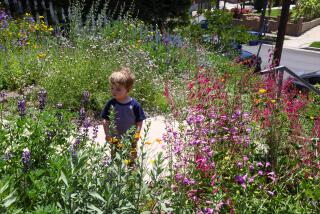Santa Barbara’s cautious relationship with water offers a drought lesson

- Share via
Reporting from SANTA BARBARA — First came the rain garden, where bees buzz around the lavender and sage. Then came the back patio, where bananas, guava, passion fruit, ginger and an herb garden are fed by water diverted from the clothes washer.
Later came the raised beds thick with kale, chard, strawberries and several varieties of squash. Finally, the native bentgrass, spread like a pale green carpet across the frontyard.
This is the home of Amy Steinfeld and Cameron Clark, a married couple who bought a 1905 Victorian farmhouse four years ago and soon began transforming it into a picture of how to do more with less water.
Their efforts have helped this resort town of 90,000 lay claim to one of the best water conservation records in Southern California, where many communities are lagging four years into the statewide drought.
Santa Barbara, known for its landscapes fed by coastal fog, has always had a cautious relationship with water. And its history of conservation may hold lessons for other upscale communities such as Beverly Hills and Rancho Santa Fe being forced to slash their hefty water consumption because of the drought.
For decades, Santa Barbara’s main water sources were reservoirs and groundwater, until a drought in the late 1980s made officials realize they needed to diversify. The city expanded its use of recycled water, joined the State Water Project and built a desalination plant, which was used only briefly in the early 1990s until the drought ended.
“Santa Barbara has hippie underpinnings and a deep commitment to the environment,” said resident Alana Tillim, who runs the Santa Barbara Dance Arts studio downtown. “We choose to live here, not in Los Angeles. We’re here because of the environment, the quietness and the beauty, and we work to keep it that way. It’s part of our culture.”
In California, overall water use dropped 13.5% in April compared with the same month in 2013. In Santa Barbara, it fell 28%. By comparison, Ventura dropped 13% and Newport Beach 3%.
Santa Barbara used 65.7 gallons of water per person in April, according to the latest figures from the State Water Resources Control Board
The Goleta Water District, which serves an area next to the city of Santa Barbara, used even less: 55 gallons per person in April. In Newport Beach, it was 99.5 gallons, and in Ventura, 74.2.
Water officials and residents say Santa Barbara’s environmental history makes locals hyper-aware of the importance of protecting natural resources. They also point to water-saving measures introduced during the earlier drought that are now being adopted by other Californians, and a responsive city program that helps residents find ways to conserve water.
“The city was already water-efficient, and they’ve just continued it into this drought,” said Madeline Ward, the city’s acting water conservation coordinator.
Santa Barbara galvanized the environmental movement — and inspired Earth Day — after an oil spill in 1969 spewed an estimated 3 million gallons of crude into the Pacific Ocean. (This year’s May 19 oil spill poured at least 21,000 gallons into coastal waters.)
During a drought from 1987 to 1991, many residents were motivated to install low-flow toilets and showers and to keep their outdoor watering to a minimum, Ward said.
In May, the city declared a Stage 3 drought emergency, which calls for a 25% citywide reduction in water use. The City Council voted Tuesday to move forward with plans to reopen the dormant desalination plant as the drought grinds on.
Santa Barbara’s main reservoir, Lake Cachuma, is down to 26% of capacity. The massive docks that once floated on the surface of Cachuma lie on rocks far above the current water line, and tall weeds cover the exposed lake bottom.
To help ease the pain, the city offers free water checkups to help home and business owners find ways to reduce their consumption. It also offers rebates of up to $1,000 for drought-tolerant landscaping and free mulch to residents for ground covering, among other incentives.
Neil Wilson, a city water conservation specialist, recently visited Tillim’s dance studio, where the water bill tripled in one month. Tillim couldn’t figure out why.
“We are drought- and water-conscious,” Tillim told Wilson. “We’re even trying to teach the kids to save water. I can’t afford to pay a higher water bill.”
He explained to Tillim how to read the water meter, and he checked the toilets and sinks. They couldn’t find what caused the problem but agreed she should attach locks to the outdoor faucets to prevent theft and check the toilets, which tend to run. Wilson told her a running toilet can lose up to a gallon a minute.
In Upper East Santa Barbara, Scott and Lisa Burns plan to hold their annual July 3 chili cook-off in their spacious backyard shaded by a majestic oak. But this time the party for about 100 will take place without Bermuda grass underfoot. They removed all 3,500 square feet this year and instead will let the falling oak leaves create a soft carpet.
Tyler Mata, another city water conservation specialist, went to their house last week to inspect the work, which included a new flagstone patio. If everything checks out, the city will give them a rebate for their efforts.
“It’s not so much about the money,” said Scott Burns, who writes commercial real estate loans. “But five years down the road, when we still have water, that’ll be what I’m happy about.”
Erica Dinkins and her husband, Brian, replaced their front lawn with an array of drought-tolerant plants a little more than a year ago. Their one-story ranch house near the Santa Barbara Mission was built by his grandfather and had an old-style front lawn that drought-conscious Californians, including Gov. Jerry Brown, consider passe.
Erica Dinkins said the transformation was emotional; she was riddled with self-doubt about what they were doing and wondered whether it would turn into a costly mistake. They spent an estimated $5,000 after rebates from the city.
Now, the front yard is alive with hummingbirds, bees and butterflies.
“It’s getting there,” she said. “Of course we had to use small plants, because the bigger you use, the more they cost. But in about four years from now, that garden is going to be epic.”
At the Steinfeld-Clark home in west Santa Barbara, the couple once thought about turning their entire front yard into a food forest. But they don’t have time for the upkeep, and they want a lawn for their son, who’s due in two months, to play on.
“We thought our neighbors might be mad at us,” Clark said, since lawns are becoming increasingly socially unacceptable.
So they attached a small sign to their white picket fence, explaining that it is drought-tolerant.
Twitter: @amcovarrubias
More to Read
Sign up for Essential California
The most important California stories and recommendations in your inbox every morning.
You may occasionally receive promotional content from the Los Angeles Times.











